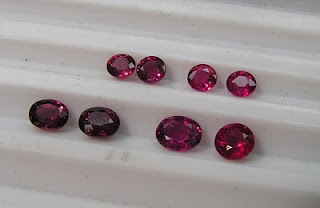When I first started to play around with gemstone beads, I was really confused. I didn’t know you could buy the genuine article – peridot, amethyst, ruby – in bead form. I thought all beads were glass or plastic or what have you. The second thing I wondered is why the beads were so cheap. “Cheap” here is relative, but when you see, let’s say, aquamarine jewelry in a jewelry store, it might cost you hundreds of dollars. So why was it possible to buy a strand of aquamarine rondelles for between $15 and $40?
Part of the difference is simply wholesale vs. retail of course. And the markup can easily be x5, when you consider all the other costs: shopping for stones, making jewelry, running a store or a website, paying store help, etc. These costs, I have come to learn, can vastly outstrip your cost of materials.
But this isn’t the whole story. The rest of it has to do with the quality of the gem, and the cutting grade. I have said it more than once, it takes up to an hour to cut a gemstone. But beads can also be tumbled, or cut into rounds. Some of the faceted ones are machine faceted (Hong Kong does a lot of this), some are hand faceted (these beads mostly come from India
What about quality? More than once, I’ve seen a “jewelry designer” approach D’s booth (you can here read the derogatory quotes as “someone who knows how to string beads”) who wanted emerald, or ruby beads, but the “really nice kind,” for a beaded bracelet. But nobody in their right mind would cut the “really nice kind” into a bead. One such bead could then cost you as much as $50, or even $150. If you have a really nice gem, it is worth cutting it with as many facets as possible, taking your time, and not – certainly not – drilling a hole through it at the end.
A bead can be – doesn’t have to be, but can be – totally worthless material, what you pay for is some minimal cutting labor (since you’re paying somebody in India
Are you with me so far? Well, I am now going to contradict myself. In some cases, the materials used for beads and gems can be the same. That’s the case when the rough is super-abundant, clear and pretty, or additionally, when the treatments needed to change its color are identical, whether it is sold in bead or gem form. The latter is the case with blue topaz, for instance. The heat treatment needed for sky and Swiss blue, the irradiation for London blue, and the surface coating for Mystic and Pink, are often done in labs in Switzerland and Germany, where labor costs are high. So you pay several bucks a carat for the stuff, regardless of whether you’re getting a bead or a gem. Beads start at $1.00 and top out at about $4 per carat, the going wholesale price for gems is $3-4 also.
So, what follows is a list of when you should expect quality differences between beads and gems, and their degree. Let me stick to a comparison to high grade briolettes only, which are the most expensive your bead money can buy.
Pretty much no material difference between beads and gems:
Amethyst, citrine, crystal, smoky quartz, rose quartz, moonstone, labradorite, and any kind of topaz.
Some differences:
Iolite, kyanite, red garnet, chrome diopside, sun stone, apatite (you can get some very nice quality in beads in all of these, but you have to look). Prices for the gems can be 3x -10x the bead price, excepting very fine cutting or large sizes which can run you even more.
Can vary:
Peridot, tourmaline (mostly a big difference, but I’ve seen some very nice beads), Mexican fire opal, andalusite, industrial grade diamond. Again, excepting very large gems and very unusual origins (like Paraiba tourmaline), etc, the gem prices will be x5 – x15.
Big difference:
Sapphire (watch for the dyed stuff, expect only Tanzanian origin, expect heat treatment), aquamarine, zircon, spinel, spessartite, tsavorite (the last three are never treated, but only the very clear stuff is used in gemstone cutting). Tanzanian sapphire beads (and sometimes gems) will cost $3-5 per carat usually, a Ceylon sapphire, which would never be cut into a bead, can cost $250 per carat for something in the 3mm size (about $20-25 per stone), and perhaps $1000 per carat for something of a few carats, cornflower color.
Night and Day:
Tanzanite (all beads are heavily included, if not opaque, though not usually dyed)
Ruby (beads are usually opaque, meaning dyed, or glass filled, never Burmese origin)
Alexandrite (huge quality difference, but no treatment either way)
Emerald (beads can be dyed, treated with fillers, but sometimes also natural, though included)
Precious opal (those are thin slivers, they cannot even be cut into any kind of bead)
Grading report diamond (“grading report” says it all)
 |
| Dyed Ruby Briolettes |
 |
| Natural and Unheated Burmese Rubies |
Here are two examples of price differentials in the “Night and Day” category: a one carat Russian Alexandrite, if you can find one, can cost you $10,000. A three carat old mine Burma ruby that is untreated, a gem you may never see in your lifetime (I’ve see only 1 carat stones which are much cheaper in comparison), can cost you $300,000.
For the most top quality beads, and good price comparisons, go to ratnasagarjewels.com. They disclose all treatment and origin of their beads – this is very rare – they do all their own cutting in Jaipur, and their cutting grade for beads is excellent.
Generally, don’t expect to know where your beads come from. And as to treatment, expect that whenever treatment is available to make the bead nicer, it is most likely used. Beware of the prefix “hydro” – this means “lab grown.”